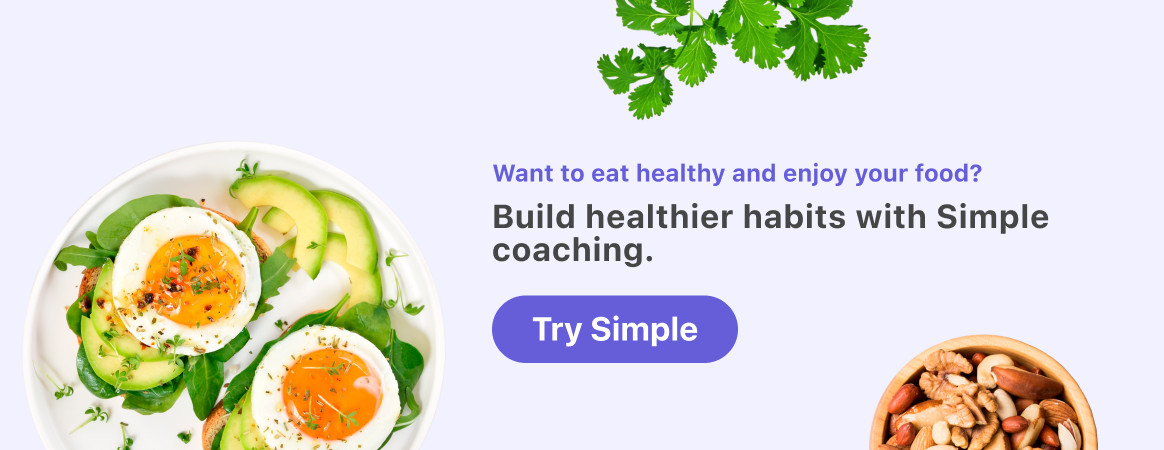15 intermittent fasting tips to help you stay on track

Whether you’re part of the intermittent fasting for beginners cohort or you’ve been fasting for years, there’s always room to learn more fasting tips and tricks for getting started, maintaining momentum, and steering toward your goals.

Unfortunately, intermittent fasting isn’t the eating routine equivalent of the magic jeans from The Sisterhood of the Traveling Pants: there isn’t one routine or style that seamlessly fits everyone. What fits the contours of your body, schedule, and lifestyle may not work for someone else.
So, to help you tailor your approach to your best possible fit, we’ve stitched together our best intermittent fasting tips for styling success.

Our top 15 intermittent fasting tips
Imagine going into a shop, closing your eyes, spinning around a few times, and then picking three random items off the rack. What are the odds they fit? Or match your style? Or even form a complete outfit?
To set yourself up for an intermittent fasting experience that not only fits you but also meets all your needs without compromising on your health and well-being, check with your healthcare provider to ensure fasting is possibly an appropriate eating routine for you. There are some people who should avoid fasting altogether (we explain more in “Is intermittent fasting safe?”).
If you’re okay to try this eating routine, we can help you style the experience your way. Beyond the fasting tricks we cover here, you can also take our Simple quiz to:
- explore what schedules might work for you and your body;
- learn how to start intermittent fasting;
- understand what to eat to maximize results; and
- get answers to common questions like “Does fasting lower blood pressure?” and “Does intermittent fasting slow metabolism?”
1. Know why you’re fasting in the first place
If you’ve experienced confusion from vague dress codes that assume “business casual” or “summer cocktail” means the same thing to everyone, you’re already ahead of one of our top tips for fasting: having clear objectives is crucial for meeting expectations. There are loads of different fasting approaches out there, and the key to finding your best eating routine lies in aligning the approach to your specific goals (as well as your nutritional needs, lifestyle, budget, schedule, and all the other things that make you “you”).
2. Choose the right schedule for you

Intermittent fasting may not have quite as many customization options as Cher’s closet in Clueless (as if!), but there are still lots of factors to consider. Don’t just ask if fasting is good for you. Ask if a specific approach is good for your goals, needs, sleep habits, meal time preferences, physical activity regimen, and other lifestyle elements.
You also want to plan eating and fasting windows carefully. Your intermittent fasting schedule should fit around your life — not the other way around — so pick an approach that gels easily with day-to-day life, social events, and other commitments.
3. Educate yourself on what to expect and be prepared for some bumps
Can you knit a sweater perfectly on the first try? Probably not. But if you familiarize yourself with different stitches and give yourself time to get into a rhythm, you might eventually. While everyone experiences fasting differently, it’s a similar concept — you’re trying something new, so understand possible hurdles and give your body time to adjust. It’s normal to encounter things like headaches and low energy. Keep an eye on them; they might just be a sign that you’re pushing through a learning curve rather than reaching a dead end.
4. Start slowly and gradually
Safe, effective, and sustainable intermittent fasting is always a gradual process, so there’s no need to approach it like a blow-out Black Friday sale. Start with a time-restricted eating approach that extends the natural fast you undergo while sleeping and avoid fasts longer than 18 hours without medical supervision — they’re higher-risk, and “more” isn’t “better” when it comes to fasting.
5. Prep your meals and pantry ahead of time
Much like buying a new top, you want an eating routine that appeals to you and fits your unique self — not one you need to force yourself into or bend over backward to try on. That’s why a big part of sticking to your intermittent fasting schedule involves building meals around foods you actually want to eat while still considering your reasons for fasting.
To ensure what you eat nourishes both your body and soul, we recommend having an intermittent fasting meal plan to guide your eating routine. Before your next trip to the grocery store, read up on what to eat during intermittent fasting and what breaks a fast to give you a solid grasp of how to meal plan for each day.
We can also offer more personalized tips on intermittent fasting meal plans that spark joy in your tastebuds while still serving your goals. Start by telling us a bit more about you (and what you like to eat!) with our Simple quiz.

6. Focus on eating nutrient-dense, protein-rich foods
Just because you eat less or less often doesn’t mean your body needs less nutrition. Eating health-promoting foods like fruits, vegetables, whole grains, lean and plant-based protein, dairy (or calcium-fortified, dairy-free foods), and nuts / seeds not only ensures you’re getting all the nutrients you need but also keeps you fuller for longer, helps you manage your blood sugar, and fends off pesky potential side effects. You can also check out our 16:8 intermittent fasting 7-day meal plan for ideas.
7. Limit foods high in refined carbs or trans / saturated fats
Just as there’s no such thing as an inherently wrong fashion choice (unless we’re talking flip-flops in the snow or a parka in the tropics … ), there’s no inherently bad food. Plus, life is too short and stressful to create undue pressure through arbitrary food avoidances or calorie restriction — even if your fasting goals are related to weight management or building lean muscle, it’s okay to eat a bowl of ice cream or an entire box of cheesy crackers sometimes. If you’re looking to maximize results, just try to limit ultra-processed, greasy, fried, and sugary foods, as they can spike blood sugar and spur hunger / cravings.
8. Limit or reduce alcohol intake
You don’t need to undergo a teetotal makeover during intermittent fasting, but you want to avoid drinking excessive amounts of alcohol (which has been linked to health risks like heart disease, type 2 diabetes, and certain cancers).[1] Drinking excessively can also exacerbate intermittent fasting side effects (like poor sleep, headaches, and increased appetite) or lead to intermittent fasting mistakes (like dehydration or overeating).
What’s considered “excessive” can vary from person to person, but as a benchmark, the CDC’s definition of moderate drinking is up to two drinks a day for men and one for women.[2] If you’re set to have a drinking-heavy time, you can also strategize to reduce alcohol-related calories (like aiming for single-spirit drinks and low-to-no-calorie mixers).
9. Become BFFs with your water bottle

Although every fasting experience is different, there is one accessory that fits every body, every day: water. Staying hydrated is extra important while you’re fasting because water helps with a whole lot of valuable body stuff, like removing waste, burning fat, and regulating blood pressure. If you’re not a fan of plain H2O, jazz it up with fruits, herbs, or spices. Some other low-calorie drinks like black coffee, diet soda, and plain, unsweetened green tea also contain water, but you’ll want to be conscious of caffeine and potential artificial sweetener side effects. Check out our “What you can drink while fasting” guide for more tips on fasting-safe drinking habits.
10. Adjust your physical activity schedule, but don’t stop altogether
While you don’t want to overdo it on physical activity and underdo it on fuel intake — which can lead to injury, illness, or burnout — you can pair intermittent fasting and working out in a safe and smart way. Certain types of physical activity may even enhance your results (not to mention the positive effects of physical activity on your overall health and well-being).
The key is to tailor the workout type, level, and length to your goals, needs, and well-being. For example, combining strength training with intermittent fasting can promote fat loss and lean muscle mass,[3] while cardio can help decrease abdominal fat and waist circumference.[4,5]
To combine the two safely, we recommend only doing high-intensity workouts during your eating window and only doing short, low-intensity workouts toward the end of your fasting window. If you have any medical conditions that impact your mobility, we recommend you speak with your healthcare provider before making any changes to your exercise routine.
11. Get enough sleep
Sleep is another one of those lifestyle accessories that fits every body on every occasion. It plays a critical role in mood and cognitive functioning as well as mental, cardiovascular, and metabolic health.[6] If you’re fasting for weight management, sleep is also a powerful weight loss tool.[7] Plus, poor sleep may not only increase your appetite but also contribute to weight / fat gain.[8] Everyone has different optimal sleep requirements, but we recommend seven or more hours a night.[9]
12. Minimize stress
Stress is like trying to pick an outfit for unpredictable weather: we can’t prevent what life throws at us, but we can prepare for it. Chronic exposure to cortisol, the hormone produced during periods of stress, can directly counter certain potential intermittent fasting benefits (like reduced inflammation, lower blood pressure, and weight management).[10,11,12] To support both fasting and overall well-being, try managing stress through techniques like deep breathing, progressive muscle relaxation, or guided visualization (or kicking the crap out of a punching bag, if that’s more your style).
13. Check in with your routine and body regularly
One of the coolest things about intermittent fasting is that it’s flexible and customizable, so you don’t have to grit your teeth through a routine that’s too tight or too loose. Having regular “how’s this feeling” check-ins can help you stay on track with your goals and needs while also ensuring you catch any potential problems or safety issues early.
14. Practice self-compassion, not self-judgment
Particularly when you’re just starting out, intermittent fasting can feel like breaking in a new pair of shoes — it’s not immediately comfy, and you may not be able to go as far those first few days. Respecting your limits and praising your milestones rather than dwelling on setbacks and stewing in frustration will keep your mental and physical self working in harmony.
15. Enlist a support group or hype squad

Even if no one in your household or social circle is shopping for an intermittent fasting schedule with you, you don’t have to go to the store alone. Having family and friends supporting you and helping you figure out what works means you have not only extra cheerleaders and motivators but also safeguards in place.
So, what are the benefits of intermittent fasting?
Since intermittent fasting isn’t a magical one-size-fits-all situation, the benefits of intermittent fasting can also vary from person to person. Plus, there are so many different variables involved in a person’s health that some benefits may not always apply to everyone.
Here are some common, science-backed benefits you may encounter through this eating routine.
Lower inflammation
Inflammation contributes to many chronic and acute illnesses, like high blood pressure and heart disease. Some studies have linked intermittent fasting to reducing inflammation and inflammatory diseases.[10]
Lower risk of type 2 diabetes
Intermittent fasting can improve insulin sensitivity, reduce insulin resistance, and decrease both cholesterol and blood glucose levels for individuals living with overweight and obesity.[13,14]
A healthier heart
By lowering inflammation, cholesterol, blood sugar, and insulin resistance, intermittent fasting may also support our cardiovascular health.[4]
A healthier brain
One short-term study suggested that intermittent fasting can enhance circulating BDNF (a protein that plays an important role in the growth and survival of nerve cells), which may lead to an increase in BDNF in the brain, too.[15] However, research so far is largely limited to animal studies, so it’s an exciting possibility, but we’re not sure yet if it’s true for humans!
Metabolic changes
Some research suggests fasting may introduce beneficial metabolic changes, like it may increase your metabolic rate and your ability to oxidize fat.[16]

- Levesque C, Sanger N, Edalati H, Sohi I, Shield KD, Sherk A, et al. A systematic review of relative risks for the relationship between chronic alcohol use and the occurrence of disease. Alcohol. 2023 Jul;47(7):1238–55.
- Centers for Disease and Control Prevention. Alcohol and public health. Dietary Guidelines for Alcohol. 2022.
- Keenan S, Cooke MB, Belski R. The Effects of Intermittent Fasting Combined with Resistance Training on Lean Body Mass: A Systematic Review of Human Studies. Nutrients [Internet]. 2020 Aug 6;12(8).
- Yang F, Liu C, Liu X, Pan X, Li X, Tian L, et al. Effect of Epidemic Intermittent Fasting on Cardiometabolic Risk Factors: A Systematic Review and Meta-Analysis of Randomized Controlled Trials. Front Nutr. 2021 Oct 18;8:669325.
- Lemes ÍR, Turi-Lynch BC, Cavero-Redondo I, Linares SN, Monteiro HL. Aerobic training reduces blood pressure and waist circumference and increases HDL-c in metabolic syndrome: a systematic review and meta-analysis of randomized controlled trials. J Am Soc Hypertens. 2018 Aug;12(8):580–8.
- Ramar K, Malhotra RK, Carden KA, Martin JL, Abbasi-Feinberg F, Aurora RN, et al. Sleep is essential to health: an American Academy of Sleep Medicine position statement. J Clin Sleep Med. 2021 Oct 1;17(10):2115–9.
- Papatriantafyllou E, Efthymiou D, Zoumbaneas E, Popescu CA, Vassilopoulou E. Sleep Deprivation: Effects on Weight Loss and Weight Loss Maintenance. Nutrients [Internet]. 2022 Apr 8;14(8).
- Soltanieh S, Solgi S, Ansari M, Santos HO, Abbasi B. Effect of sleep duration on dietary intake, desire to eat, measures of food intake and metabolic hormones: A systematic review of clinical trials. Clin Nutr ESPEN. 2021 Oct;45:55–65.
- Watson NF, Badr MS, Belenky G, Bliwise DL, Buxton OM, Buysse D, et al. Recommended Amount of Sleep for a Healthy Adult: A Joint Consensus Statement of the American Academy of Sleep Medicine and Sleep Research Society. Sleep. 2015 Jun 1;38(6):843–4.
- Wang X, Yang Q, Liao Q, Li M, Zhang P, Santos HO, et al. Effects of intermittent fasting diets on plasma concentrations of inflammatory biomarkers: A systematic review and meta-analysis of randomized controlled trials. Nutrition. 2020 Aug 12;79-80:110974.
- Wang W, Wei R, Pan Q, Guo L. Beneficial effect of time-restricted eating on blood pressure: a systematic meta-analysis and meta-regression analysis. Nutr Metab . 2022 Nov 8;19(1):77.
- Welton S, Minty R, O’Driscoll T, Willms H, Poirier D, Madden S, et al. Intermittent fasting and weight loss: Systematic review. Can Fam Physician. 2020 Feb;66(2):117–25.
- Albosta M, Bakke J. Intermittent fasting: is there a role in the treatment of diabetes? A review of the literature and guide for primary care physicians. Clin Diabetes Endocrinol. 2021 Feb 3;7(1):3.
- Meng H, Zhu L, Kord-Varkaneh H, O Santos H, Tinsley GM, Fu P. Effects of intermittent fasting and energy-restricted diets on lipid profile: A systematic review and meta-analysis. Nutrition. 2020 Sep;77:110801.
- Jamshed H, Beyl RA, Della Manna DL, Yang ES, Ravussin E, Peterson CM. Early Time-Restricted Feeding Improves 24-Hour Glucose Levels and Affects Markers of the Circadian Clock, Aging, and Autophagy in Humans. Nutrients [Internet]. 2019 May 30;11(6).
- Patterson RE, Sears DD. Metabolic Effects of Intermittent Fasting. Annu Rev Nutr. 2017 Aug 21;37:371–93.
